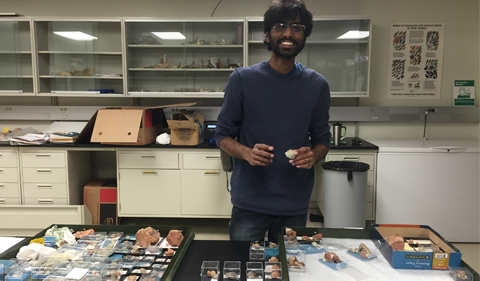Ohio University faculty and alumni published an article about the discovery of six new species of invertebrates found during a paleontological exploration of rift deposits in southwestern Tanzania.
After analyzing invertebrate fossils that were alive 24 to 26 million years ago in the Rukwa Rift Basin, OHIO paleontologists published the first documentation of a rapid diversification of freshwater gastropod species at a time of pivotal environment change in this specific area.
Their paper on “Morphological diversification of ampullariid gastropods (Nsungwe Formation, Late Oligocene, Rukwa Rift Basin, Tanzania) is coincident with onset of East African rifting” was published in Papers in Paleontology.
The authors are: Y. Ranjeev Epa, who earned an M.S. in Geology 2017 and who is now pursuing a Ph.D. at the University of Missouri; Dr. Alycia L. Stigall, Professor of Geological Sciences at OHIO; Dr. Eric M. Roberts, head of Geoscience at James Cook University in Australia; Dr. Haley D. O’Brien, who earned a Ph.D. in Biological Sciences in 2016 and is now assistant professor in the Department of Anatomy and Cell Biology at Oklahoma State University’s Center for Health Sciences; and Dr. Nancy J. Stevens, Professor of Biomedical Sciences at OHIO.
“From the very start of this project, I was extremely intrigued because we were working on rare fossils from a geologically interesting location,” said Epa, who studied and identified the fossils for his thesis. “These fossils had a lot of interesting stories to tell us and I am very happy that we were able to expand the existing knowledge on the evolutionary history, ecology and biogeography of this family.”
The new species evolved in what is now known as the East African Rift about 25 million years ago, as the Horn of Africa began splitting away from the mainland due to movements of the earth’s plates. This interval in time is called the late Oligocene, a key period of transition between ancient and more modern ecosystems. The research team emphasized how the discovery of these new species can help us understand how organisms respond to environmental change.
“The timing of this evolutionary burst is coincident with the onset of the timing of the East African Rift,” said Stigall, a researcher on the team. “The new rift produced novel environments, and the gastropods very rapidly evolved to exploit new niches.”
The fossils examined in the study were collected by Stevens and her research group, which has been conducting paleobiological and geological research in the Rukwa Rift Basin in Tanzania for nearly two decades. Their research has produced the most precise age for the onset of rifting in the western branch of the East African Rift System, as well as the earliest evidence of the split between Old World monkeys and apes. Until now, the evolutionary history of invertebrate faunas in this area have barely been studied.
Previously, the Rukwa Rift Basin team has reported on the discovery of other new species to science, including dinosaurs and bizarre mammal-like crocs from older deposits in the region. It is clear that the Rukwa Rift preserves a special window into the evolution of ecosystems on the African continent, with potentially even more discoveries to come.
- See OHIO news release headlined “OHIO Paleontologists discovered six new species in the East African Rift.”
- See “Paleontologists Find New Snail Species with Evolutionary Speed.”
Abstract for “Morphological diversification of ampullariid gastropods (Nsungwe Formation, Late Oligocene, Rukwa Rift Basin, Tanzania) is coincident with onset of East African rifting;” A new freshwater gastropod fauna is described from the late Oligocene Nsungwe Formation of the Rukwa Rift Basin, Tanzania. Six new species of ampullariids are established including five species of Lanistes (L. microovum, L. nsungwensis, L. rukwaensis, L. songwellipticus and L. songweovum) and one species of Carnevalea (C. santiapillaii). These taxa occupy a morphospace region comparable to nearly half of extant Lanistes, a common and widespread genus in Africa and Madagascar. Palaeoecological evidence indicates that Nsungwe ampullariids inhabited fluvial, pond and paludal environments. Among these species are the oldest high‐spired and fluvially adapated Lanistes taxa. We suggest that Nsungwe Lanistes rapidly diversified in concert with habitat heterogeneity associated with the initiation of rifting along the western branch of the East African Rift System (EARS). Taxonomy, evolution and the biogeographical affinities of Nsungwe Formation freshwater gastropods contributes significantly to expanding the undersampled Palaeogene invertebrate fossil record of continental Africa.




















Comments